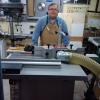Matching curves for cutting boards- The reason the pieces won't mate and you can't successfully use almost all of the techniques suggested in this thread is simple geometry. You especially can't use the technique where you route curved kerf partially through the boards, bandsaw down the middle of the keft, and flush trim the waste. It just won't work. Likewise you can't use the cut piece and router with bearing bit- the same thing happens.
Let's see if I can do this- I don't have privileges any more so can't see other's pics, but hopefully you can see mine.
In the following SketchUp drawings I used an exaggerated curve and simulated a 3/8" wide kerf to make a near triangular shaped piece and mating piece- not quite the worst case but close! As expected, the perpendicular distance between all points on opposite sides of the kerf is 3/8" and as the pieces are brought together at the apex they meet after moving 3/8." However you are not moving the other angled surfaces perpendicular to t tje surface of the angle, you are moving them obliquely so the angled segments will never both meet. Remember this a a worst case scenario. The shallower the curve the closer the curves will get, but unless both surfaces are flat and parallel (horizontal in my drawing) they will never mate perfectly.
board.jpg
board2.jpg
board3.jpg
Someone mentioned the Bondo method to make complementary templates- I concur. I used that technique to quickly make templates before, e.g. use that to a template to cut the opening in the top of my router table that matched the radius of the corners of the router mounting plate. It is quick and easy and doesn't require a lot of precision: Draw the desired pattern on template #1. Bandsaw, file, and sand for a smooth, pleasing profile. Trace the profile onto stock for template #2 and cut it out with a bandsaw- it just has to be close, not precise. Remove any high spots so they roughly mate. Then cover the edge of template #1 with thin plastic tape. Mix and spread Bondo onto the mating edge of template #2. Force and clamp the templates together. Once the Bondo has hardened, clean excess Bondo from the top and bottom faces of template #2 and you will have two templates that mate perfectly and can be used with a flush trim router bit to make mating pieces of cutting board.
Can everyone see the drawings? I can't. My apologies to Glenn if his post demonstrated the same principles.





 Reply With Quote
Reply With Quote




